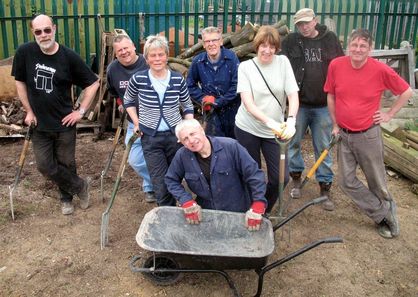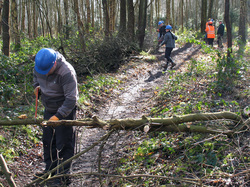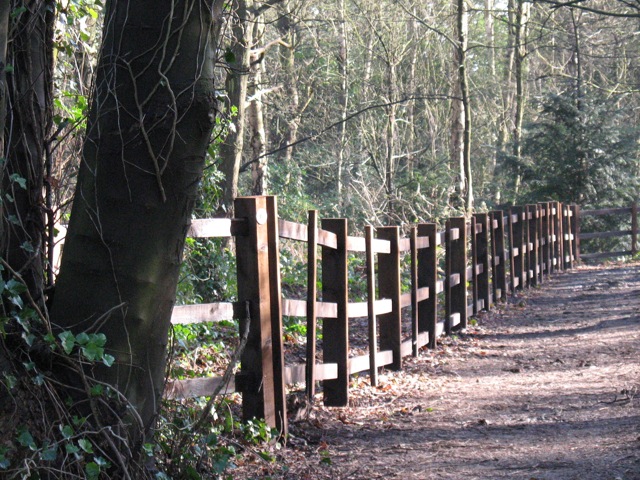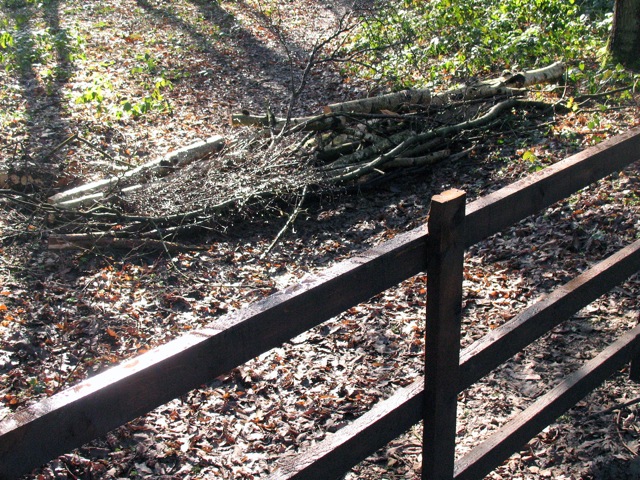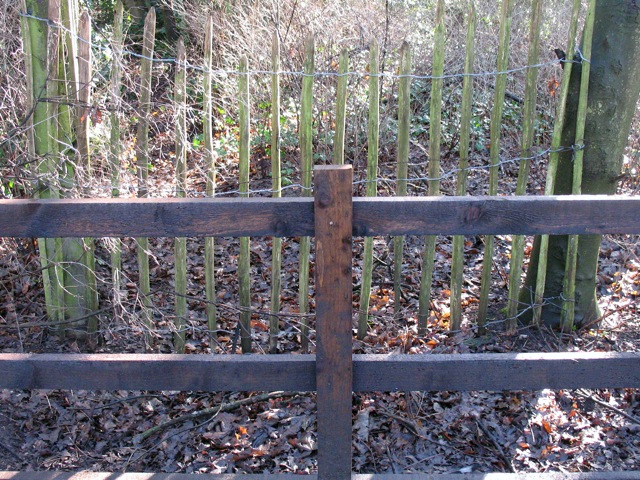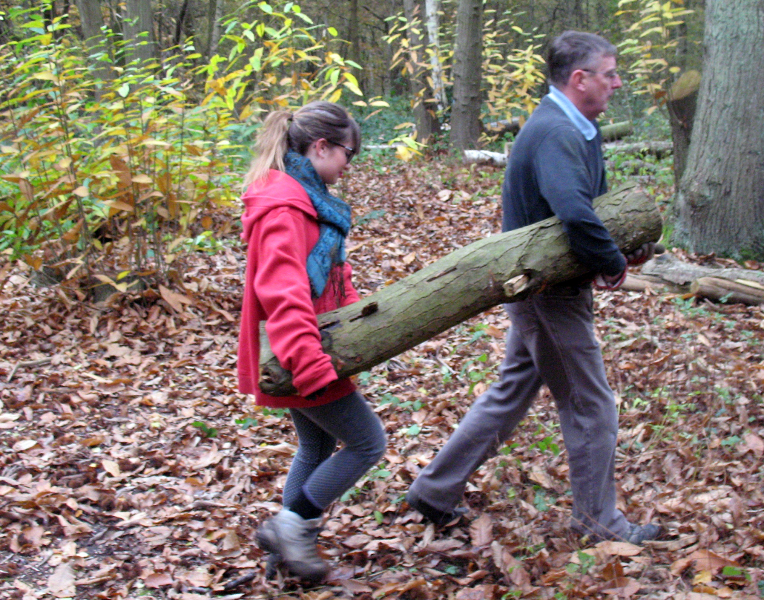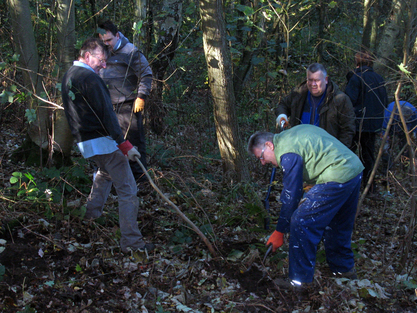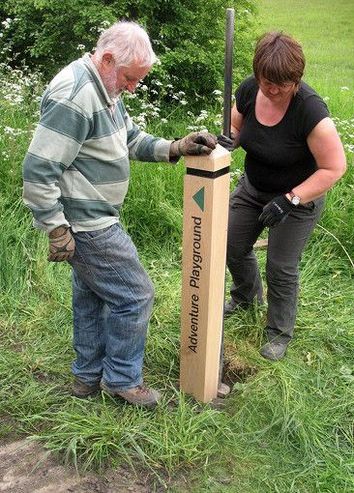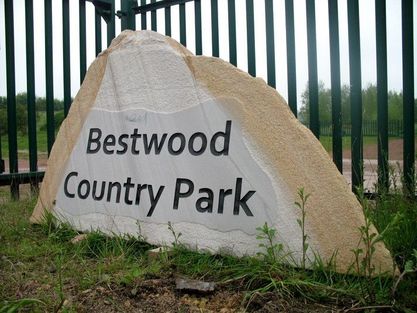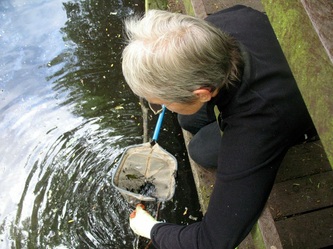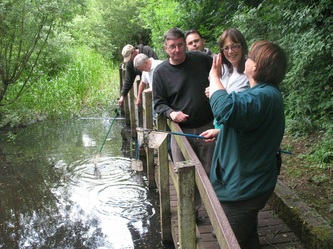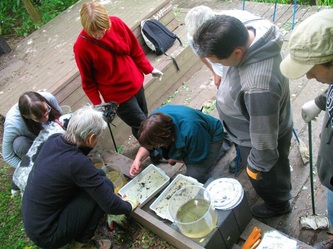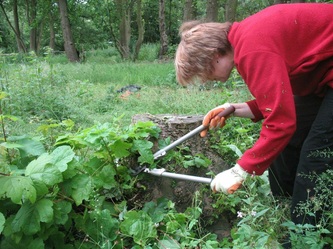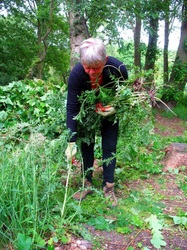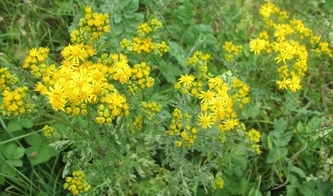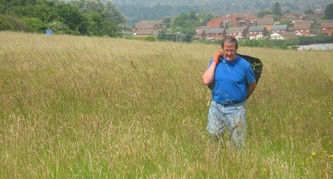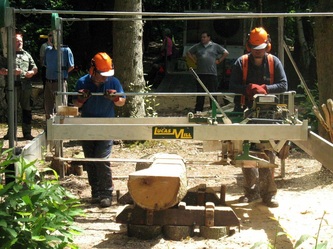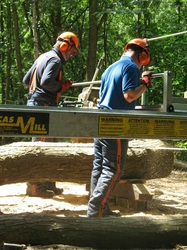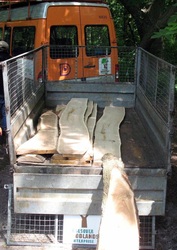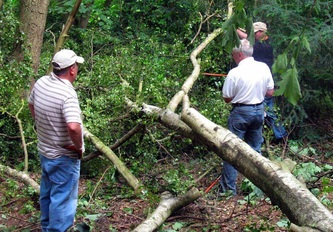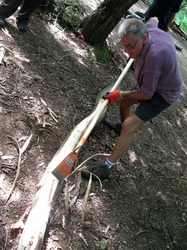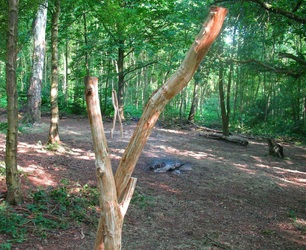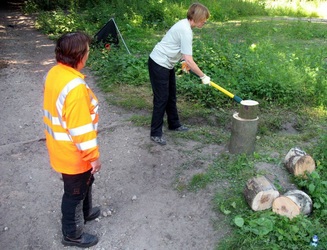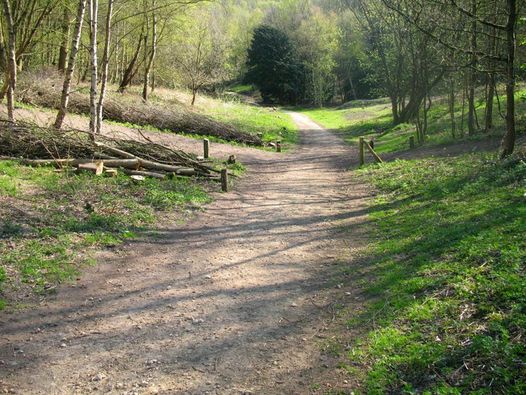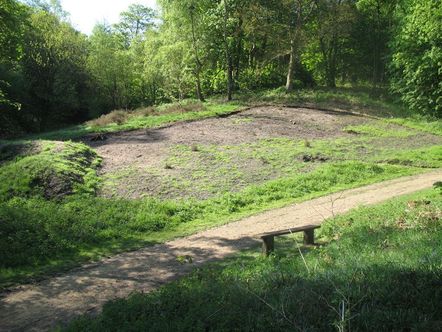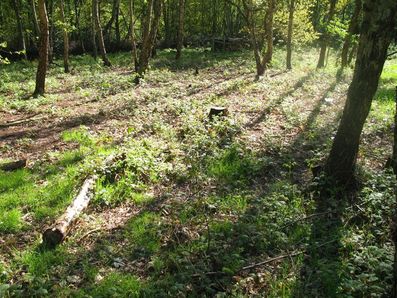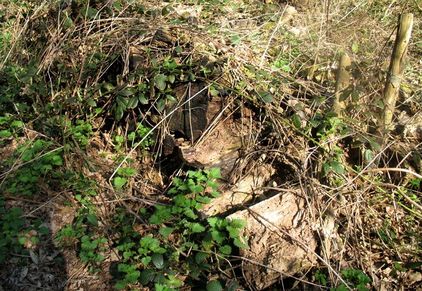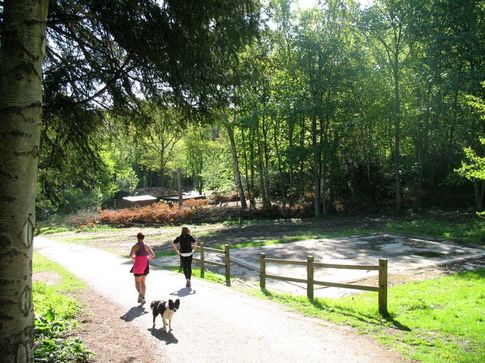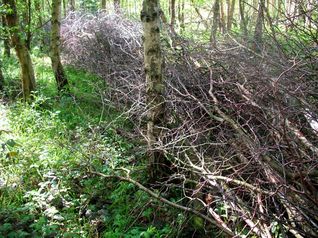|
Meet a Vole
Find out more about the longest serving park volunteer by clicking here.
|
A YEAR IN THE LIFE OF THE VOLES
Autumn through to Spring
Knowing When To Stop
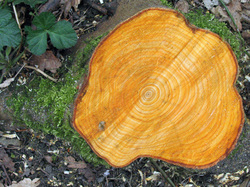 Sap discolouring a recently felled Norwegian Maple
Sap discolouring a recently felled Norwegian Maple
As the warm weather entices more ‘yoths’ into the park, we can expect to be filling unwanted holes, repairing destroyed infrastructure and coping with the embers of open fires set by numb-skulls whose joined-up thinking doesn’t run to putting together the dangers of burning wood in woodland.
Click on any of the following images to enlarge them
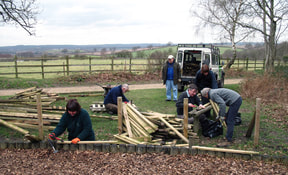 Stripping down the vandalised Adventure Playground fence.
Stripping down the vandalised Adventure Playground fence.
Of course, some don’t even compute that woods tend to be littered with dead wood ideal for a roaring blaze, but rather set to work pillaging wooden fences, like those once embedded around the adventure playground. Since what they left standing was neither use nor ornament, one of our tasks over the winter months was to jemmy off the slats, lever out the nails, dig out the uprights and smash off their concrete settings ready for recycling the wood, or at least stashing for a rainy day. It was two days of graft that would have been better spent sorting the woodland, a task that rarely achieves all that is required, particular now the park is under-staffed.
Bringing in the Light
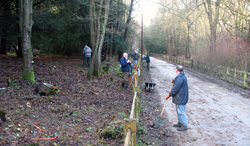 Opening up the Khalsa Wood side of Park Road.
Opening up the Khalsa Wood side of Park Road.
This year we made an all-out assault on the southern length of Park Road (the northern stretch of Bramley Wood is privately owned) so at least one side of what was once an impressive avenue now has room to breathe.
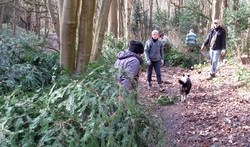 Building Yew windrows south of Woodman’s Path.
Building Yew windrows south of Woodman’s Path.
On the Front Line, cheek-by-jowl with Top Valley estate, contractors had done the fun work of felling, leaving us the task of clearing up after them.
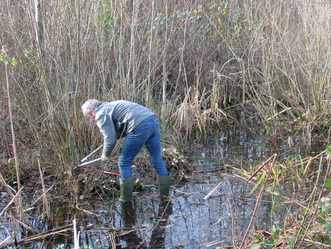 Trimming back the alder & willow that clutter up the Pit Tip conservation area
Trimming back the alder & willow that clutter up the Pit Tip conservation area
Secured behind wire fencing and off limits to the public, our target area is a small patch of furrowed land, hidden behind a weave of branches, which habitually becomes over-burdened with willow and alder. Water collects in the furrows, making this secluded spot a refuge for pond life and the snipe, woodcock and heron that has in turn been enticed in.
Riders Without Horse Sense
Other Work
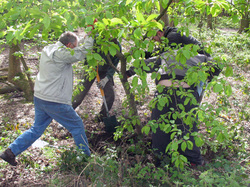 Rooting out a cherry tree that just isn’t
welcome near The Triangle.
Rooting out a cherry tree that just isn’t
welcome near The Triangle.
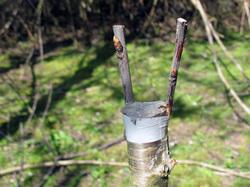 The Phantom Grafter strikes again!
The Phantom Grafter strikes again!
He or she rather helpfully bound them round with blue, red, white or yellow tape, the clearer for us to notice them and rip ‘em out!
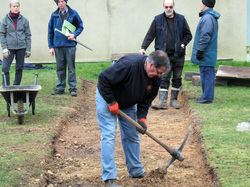 Backbreaking work watching somebody else digging
Backbreaking work watching somebody else digging
We begrudged them purely because it was dreadful work involving picks and shovels and sometimes digging on our knees. We like a challenge, but during the winter months we prefer it to be arboreal, particularly when a JCB could have polished off the task in a couple of hours.
Public Goes Private - Spring Supplement
|
Perhaps the most pernicious consequence of this country’s relentless drive to privatise public services and sell off public property at knock-down prices is the loss of open space. Whether forests, playing fields, brownfield sites or parklands, any passing of public land into the hands of wealth is to be mourned. Of course, elsewhere in Europe such blatant irresponsibility on the part of local and national government precipitates, at minimum, public protest and at worst, riots and the loss of life. In an overcrowded island like ours, where open space is at a premium, we shrug our shoulders or at best sign an on-line petition.
Bestwood boasts its own small example of this creeping cancer in the selling off of a tip of Gaunt Hill, west of the Fire Station, now isolated behind a firm wooden fence. Erected with due haste by its new owners, this ‘tasteful’ barrier immediately outraged regular walkers following the desire lines from the hotel car park, behind the Landman Compound, to the Big Wood Corner, a route that saved them from the occasionally irresponsible traffic on the track to the residences and Woodside Liveries. In time, it is possible the new owners will do a better job of woodland management than the authorities and walkers will resign themselves to the dogleg now provided round their ‘manor’. The sadness is that they could just as easily provided a permissive way across this corner of woodland and thus ingratiate themselves with the local community, but they evidently felt what is theirs is theirs, full stop. The argument that the containment will hopefully encourage wood anemone to return is spurious since wood anemones were never there in the first place. At the same time we mourn the passing of a full team of Rangers and support staff, victims of the cuts. When your correspondent joined the volunteers there were seven Rangers and an office support worker based in Alexander Lodge and an education officer based in the classroom nearby. Over the years that team has been whittled down to two Rangers (now employed by Gedling Borough) and a Community Liaison Officer (employed by the County). The volunteers were witnesses to the anxiety and trauma this inflicted on the staff, not knowing if they had a job to go to from one week to the next, and to the park, now grossly understaffed considering it is the largest, most diverse public space in Nottinghamshire. Now more than ever the management of the woodlands, lakes and pit top are dependent on the labour of volunteers, for which you would imagine the authorities would be grateful. If only… |
Notes from the Chair
The sale was not secret, it was not sold at a knock-down price, and there are very good conservation reasons why the fencing went up.
Over the years people walking over that sensitive area had all but wiped out the wood anemone. It is hoped that protecting the area may encourage its return. Even Brick acknowledges that the owners may take better care of that piece of land than the council had previously. He fails to mention that the piece of land had been bought by the council from the previous private owners TO MAKE A CAR PARK, which thankfully they then did not follow up on. So the sale back to the private owners should be welcomed as having removed the threat of woodland being turned over to cars!
Margret Vince - Chair FoBCP
August Into Autumn
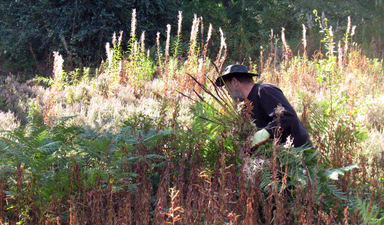 Hand weeding bracken and rosebay in Calluna Clearing
Hand weeding bracken and rosebay in Calluna Clearing
In an area the size of Calluna Clearing, the jungle of bracken might well emanate from a single plant, such is the ability of this fern to run rampant. Efforts to control it with Asulox woefully failed, and the spraying has been discontinued, so once again we will find ourselves pulling bracken by hand.
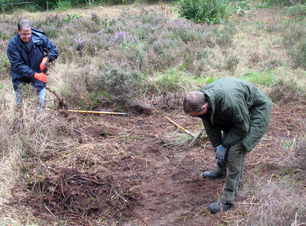 Preparing the ground for reseeding heather.
Preparing the ground for reseeding heather.
At Calluna, the heather was revealed to be suffering from old age, like some of the voles, so this year the plots were prepared for seeding anew. The ground was raked and any exposed rizhomes (the tendrils of bracken) removed or left for the frost to kill off.
In the photograph the pile of roots bottom left are bracken rizhomes.
In Khalsa Woods and south of Hanging Heath, much of this thinning is about removing sycamores, cherry and other un-welcomed species to buy space for veteran oaks to breathe.
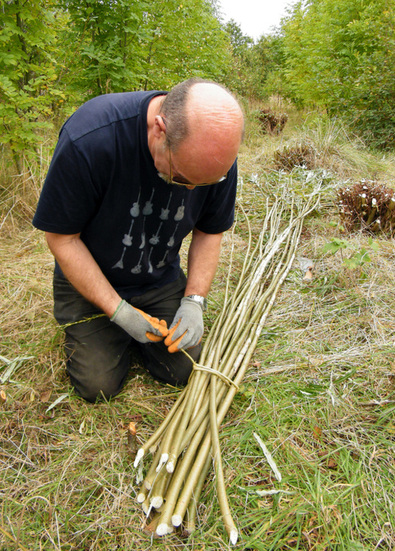 Binding a bundle of heatherings ‘harvested’ from the willow stools middle right.
Binding a bundle of heatherings ‘harvested’ from the willow stools middle right.
On the southern edge of the Pit Tip, Rise Park Conservation Area is out of bounds to the public. This is one of two areas where the park grows the willow heatherings used to bind the top of laid hedgerows, as seen south of the Winding Engine House, and on the southern edge of the Conservation Area itself.
With a hedgelaying course imminent, it was our task to clip the willows back to the stools (stumps) and harvest the alder and ash growing up there for stakes. These uprights provide the hedge infrastructure, round which the willow is then woven to keep things in place.
Every region has its own style of hedgelaying, largely dependent on its function (to keep out or contain the public, sheep or cattle, for example) each requiring a different degree of strength.
Though there are great similarities, and the Midland style deployed at Bestwood is most common, it is fascinating to spot the subtle differences. The Derby style, for example, using machined uprights, can be seen on the left of the Ollerton road leaving town, just after the turn off to Burntstump.
 Rise Park Conservation Area before and after
Rise Park Conservation Area before and after
Once upon a time, hedgelaying was an activity reserved for the voles and an occasional weekend course. Since the cutbacks and staff shortages, the amount of work the authorities depend on volunteers for has exponentially increased. Gone are the activities that increased our understanding of woodland management. In have come irregular opportunities for voles to work at Bestwood on a Thursday under the Community Liaison Officer. Should we look forward to a time when we’re also asked to do the county’s paperwork, or will somebody driving a desk finally get a grip on what ‘short-sighted’ means?
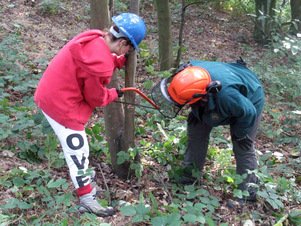
Her work placement greatly amused the staff, who happily sat back and watched us pass on everything they’ve passed on to us over the years. But we like to think we bestowed some deeper understanding upon her, if only how to handle wizened and grumpy old voles.
In this photo Sue McDonald (then a Ranger, now the CLO) is keeping a close eye on Emma as she gets to grips with a ‘gob cut’.
Early Summer Activity
Signs of the Times
Talking of signs, there are two large and very stylish name-stones at rest in the compound that would look splendid either side of the Winding Engine House park entrance. Engraved with ‘Bestwood Country Park’, they could welcome visitors with a proud flourish and a clear orientation, should sense and an accurate map ever prevail. Left over from the sandstone information blocks sited at the Mill Lakes, they were ‘donated’ by Ashfield District Council, whose jurisdiction that part of the country park comes under.
|
Sadly the name-stones fell victim to a sleep-inducing argument about their failure to display corporate logos and employ the ‘correct’ corporate font.
They have been summarily retired before seeing active service. Click on the photos to enlarge them. |
Extramural Activities
Recently, however, we were treated to an afternoon’s pond dipping from the Mill Lakes boardwalks (out-of-bounds to the public), something most of us hadn’t done since we were kids. What some thought would be a trivial waste of time proved a fascinating insight into the myriad of life swimming in and above the slime, from endlessly contorting leeches to the barely visible whatever-they-were. Evidently the mucky extremities of the lakes are as vital to the welfare of resident fowl, fish and mammals as the habitat stacks in the park. Obvious, maybe, but sometimes these things have to be seen to be appreciated.
As the local authorities become increasingly dependent on unpaid workers, such diversions from the ‘real work’ become essential, not only as a nod of gratitude, but as a learning opportunity for voles steeped in knowledge about any number of professions and trades except the one they are currently volunteering for. Anybody out there listening?
Click on the images below to enlarge them.
Whittle Down the Weeds
An equally controversial activity at this time is pulling and destroying ragwort, a weed that is designated ‘injurious’ because it might poison somebody’s cherished gee-gee, should it decide to binge on a weed disgustingly bitter to even them. Under orders from DEFRA (via the councils), every year before it seeds we uproot this botanical vermin from verges and grasslands adjacent to pastures, and every year we have the same problem of disposal. The plant can be pulled and left to rot where it lies, but it cannot be dumped in a corporation skip, even if bagged. Large quantities from harvesting a field the size of East Pasture must be incinerated.
It appears the local authority firmly believe the Weeds Act (1959) legislates that they must seek and destroy the evil ragwort, in line with other ‘notifiable weeds’. Except ragwort isn’t a ‘notifiable weed’ (there is no such a thing in UK law) and the Act does not say any weed must be eliminate from anywhere. It only states that the Secretary of State can serve an enforcement notice on the occupier of land (the County) on which injurious weeds are growing – or it did, until the British Horse Society and a Private Member’s Bill waded in 50 years later.
The word count expended in the diverse codes of practice generated by the Ragwort Control Act is a wonder to behold. Once read, it is hard not to truly admire this humble ‘weed’, a source of wholesome nutrition for over 180 species yet a tummy ache waiting to happen for a couple of pampered others. One wonders how Dobbin made it through 3,000 plus years without protection from the horsey set at Whitehall?
Click on the images below to enlarge them.
Give and Take
Aside from their nifty piece of kit and evident expertise, what’s remarkable about this Derbyshire County Council project is the workforce. Other than the two paid workers on site, the team exclusively comprised individuals who have learning disabilities. The project engages 14 such lads and lasses each day on a variety of seasonal tasks. Some have chainsaw and/or strimmer tickets. On a job like ours, BWE’s cut of the day’s work is sold on, either as raw materials or finished furniture, the profit being ploughed back into the project. How brilliant is that (and there’s a pun in there somewhere)!?
The Sweet Chestnuts were felled from the stand right of Colliers Path as you walk away from Alex’ Lodge. Once again, our work attracted derisory comments from a member of the public proud to inform us that his ‘Bodger’ credentials were impeccable and he knew vandalism when he saw it. Once again, we tried to explain… actually, we didn’t, but rather agreed that, yes, we go to all this effort purely to satisfy a deep-seated need to slowly, bit by bit, destroy the planet!
There are any number of walks one can take in Nottinghamshire that meander through badly managed woods and copses where overcrowding has blocked out the light, spawning ground cover grossly short on variety. Light, the soul food of growth, is one of the main reasons we fell mature trees… end of!
Click on the images below to enlarge them.
Odds and Ends
And we love it. Variety is probably what keeps most of us coming back, though the physical work and beautiful setting are right up there. In the past, we uncovered the Japanese Water Garden in the Bestwood Lodge Arboretum. We mended the fountain, using ye olde lime mortar. We’ve filled in holes in the Quarry, shafts over eight foot deep dug by kids yet to learn that sand has a tendency to fall in on itself. We’ve built steps, perimeter fences and enclosures. The list goes on.
Often these tasks require skills and techniques new to many voles, and those that have them invariably need more practice. They involve using tools with names like ‘shuv-holer’, ‘debarking iron’ and ‘tamper’, mundane equipment to the initiated but weirdly exotic to voles whose otherwise most commonly employed tool is a keyboard. There is something immensely satisfying about watching a new member master the wielding of a splitting axe and walk away on both legs!
Click on the images below to enlarge them.
Spring Activity
Tree Felling in the Park
The big operation to clear silver birches either side of the track up Second Valley aimed to establish a ‘ride’ that opened up vistas for the public to enjoy. The year before we broke our backs enlarging Millennium Heath, a secluded little patch to the east of the track that almost nobody knew about. Now trebled in size and extended down to the Second Valley track, it has been planted with heather and will mature into an idyllic spot where the sun can flex its rays.
Click on the images below to enlarge them.
A stiff climb south from Alex’ Lodge lies the well-established heath called Calluna Clearing. Immediately to the east we have felled, cleared and opened up more land to create a ‘glade’. This will not only encourage ground cover such as wild flowers, but also provides a link in a chain of different habitats known as a ‘mosaic’, an ideal feature of woodland management.
In both locations, the sneddings have been woven into substantial windrows, something the Monday voles are particularly skilled at. But opposite Calluna we have also built a large ‘habitat stack’ known (by us) as ‘Maggie’s Pyre’ - a fitting tribute to Thatcher’s passing on the day of its inception.
Click on the images below to enlarge them.
Some of the felled trunks were sawn into standard lengths and sold to either merchants or the public at no great cost. The money collected will pay for the voles’ mid-summer and Christmas ‘barbies’, previously funded by the County until they decided they could no longer afford to thank us for our free labour.
A final tranche of felling can be seen adjacent to the ugly toilet block near Alex’ Lodge, raised after the old wooden one was razed. This has removed dangerously fire-damaged trees and cleared sight-lines so the next wanton destruction of a public facility can be nipped in the bud (hopefully).
Click on the image below to enlarge it.
The Mill Lakes
At both the lakes and in the park, we have sadly wasted a lot of our time picking up litter and festering doggy bags. Next time anybody sees either being dropped or even carefully placed, please explain in no uncertain terms that there is not a Detritus Fairy who comes in the night…
|

